The growing market for high-mix, low-volume production has prompted the emergence of simplified yet powerful and intuitive technology that easily facilitates human-robot interaction in an industrial environment. While traditional collaborative robots have been especially beneficial for handling applications, the introduction of “hybrid” collaborative robots has unveiled a series of new applications that were previously too complex or uneconomical with classic robotic automation. Our sister company, Yaskawa Europe GmbH – Robotics Division, gives further insight into the effective use of flexible modern-day robotic technology and how it can simplify operation while reducing costs.
The promise of collaborative robotics
Collaborative robotics, human-robot interaction (MRI) or human-robot 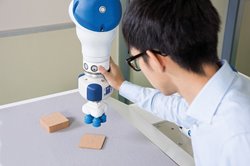 collaboration (MRK) is an innovative topic within the field of robotics.
collaboration (MRK) is an innovative topic within the field of robotics.
Almost a decade ago, the technology was developed and made ready for series production as part of an EU research programme, with the focus on the safety of human-robot interaction and the lightweight construction of such robots.
Commercialisation in recent years has been driven by a different provider – a robotics newcomer at the time, with simplified technology, a start-up mentality and modern marketing. A new, growing robot market has emerged, bringing in a fresh breath of air and causing something of a stir among the large-scale industrial robot manufacturers.
Success factors here were the simplicity of handling (operation and commissioning) and the environment of a marketing and information culture tailored to robotics newcomers. The resulting optimistic spirit has motivated many new users to take their first steps in the world of robotics, get to grips with robot technology, approach robot applications in a more pragmatic and less prejudiced manner and quickly enjoy a sense of achievement. Some of these were new applications for which conventional robotics (supposedly) seemed too bulky, too inflexible and too expensive. Industrial users making increasing use of this simple technology hoped to get rid of the tiresome protective fence that generates space requirements and costs in conventional robot cells.
There are now around 30 manufacturers of collaborative robots worldwide, mostly small robots with payloads of up to 7 kg focusing on simple handling tasks. This is one of the reasons why collaborative robotics promises to be particularly cost-effective, flexible and easy to implement.
Collaborative robotics as a future technology?
Collaborative robotics also fits into the canon of much-debated future technologies. Robotics is generally regarded as an enabler of several mega-trends. Unfortunately, the term "robotics" is often used – especially in analysts’ market reports of – to apply very undifferentiated descriptions to all kinds of things that are programmable and that move. As a result, technologies such as industrial robots, service and household robotics, sensor and navigation technology, artificial intelligence, exoskeletons, drones, vacuum cleaners and self-propelled logistics platforms tend to clustered together – and this conglomerate is used to predict huge growth rates for "robotics" in the future. Collaborative robots are seen as the evolutionary stage of conventional robotics as they bring the ethically valuable conciliatory prospect that humans and robots will no longer be competitors in the smart digital factory of the future, but will in fact work hand in hand.
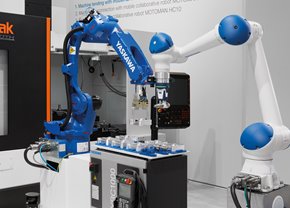
So are classic industrial robots in their cages a technology of the past? No – collaborative robotics will not replace classic robotics but will complement it. The digital factory with all its technological concepts can be excellently implemented with any kind of robotics, regardless of whether the robots are collaborative or not.
Today, collaborative robotics is seen from a more down-to-earth, differentiated perspective. Initially, the technology of collaborative robots was received with great interest. In the industrial environment (and above all in the automotive and supplier industry), technology scouting has been pursued strategically, with many pilot and lighthouse projects having been implemented. After a rather rocky start and learning to implement collaborative robotic workstations the hard way, people are now looking for “really useful applications” when it comes to collaborative robotics – i.e. applications where human-robot interaction “really” offers benefits. The aim is no longer to introduce collaborative robotics at any price but to find the right robot solution to suit the right application.
Safety
Safety assessment of robot workstations was hugely underestimated at the beginning, for example. In the meantime, the system of standards with DIN EN ISO 10218-1, ISO TS 15066 and DIN EN ISO 13849-1 has developed considerably – also with regard to safe human-robot interaction. Today, we no longer talk about a safe robot but about a safe application.
An individual safety assessment must be carried out for each collaborative workplace – not only the robot itself, but the entire workplace situation (position, directions of movement, speeds, grippers/tools, workpieces, device, safety technology) is assessed in each individual case by a certified body. In many cases even complex collision force measurements have to be carried out. The money you were actually expecting to save on the protective fence is often quickly spent elsewhere ... In the industry it is well-known that 80% of all “collaborative” robots end up behind a safety facility – in many cases a protective fence.
Cycle time
If a human being is to work with the robot, the following situation arises from the robot's point of view: as long as the human being is “in the way”, the robot has to work slowly – at a safely limited speed. This leads to short cycle times and often gets in the way of project amortisation. Many collaborative robot models on the market are so small and slow and can move such low loads that they are incapable of posing a risk to humans in terms of their design. They are not industrial robots designed for years of continuous use at maximum speed in 3-shift operation.
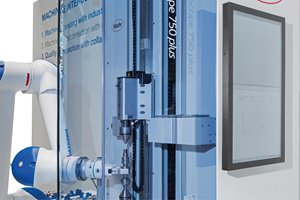
But how can a robot be safe while at the same time being almost as fast as we are familiar with from classic robotics? The answer is the
“hybrid” collaborative robot – a fully-fledged industrial robot that can work at high speed on the one hand but drops back to a safely reduced speed as soon as the human being is directly in the workspace.
What is important here is how to determine the period of human-robot interaction in relation to the total cycle time during planning. Such a breakdown according to time phases is also familiar in the planning of classic robot systems where these are equipped with a safe robot controller – this type of system is also capable of operating without a safety fence. The only difference is that the classic industrial robot has to remain in a safe position in the presence of humans, while the collaborating hybrid robot continues to work slowly and safely. Standard safety technology is used to detect whether a person is present or not (e.g. safety laser scanner, safety curtain, mat). This technology is needed in many projects – whether with or without collaborating robots – in order to intercept dangers posed by fixtures, grippers and workpieces. So it can also be used to shift the robot into a different mode.
As such, the proportional period of human/robot interaction in the total cycle time is essential in terms of designing a workstation:
Permanent human-robot interaction: If robots and humans are permanently working together, if speed is not the key factor or there may still be passenger traffic in the vicinity of the robot, collaborating robots might be the right concept. Cycle times are not a primary goal here, but rather synergy effects achieved by means of clever parallel or cooperative work between humans and robots – e.g. for assistance tasks or for enriching workpieces during manual assembly. Taking this idea stage further: there are also situations where the robot movement does not have to be carried out quickly at any price. When loading/unloading processing machines or during quality inspection processes, for example – here the processing or inspection procedure sometimes takes so long that the slower speed of a collaborating robot is accepted during the relatively short loading/unloading period in order to be able to dispense with a protective fence.
Temporary human-robot interaction: If there are lengthier phases in which humans and robots work together and other phases in which humans are not present, hybrid collaborative robots are a sensible option. Stations located in the middle of passenger traffic that is of unpredictable frequency and duration are also of interest in connection with hybrid robots.
Minimal human-robot interaction: If the human-robot interaction is limited to a very short period of time (e.g. when loading/unloading workpieces), classic industrial robots are usually a sensible option. They stop when the person is present but can make the most of their speed advantage for the rest of the time. With multi-station rotary or swivel tables, insertion times can also often be decoupled more favourably.
Plannability
But things are not always that simple: if the human being is unpredictably in the robot's workspace – sometimes for a short time and sometimes for a long time – they also influence the cycle time of the robot station. This makes cycle time and part throughput unpredictable. How is it possible to plan the output of the assembly cell and track how many parts can be produced? What is the forecast? With conventional robot cells, this can be easily calculated in the planning phase.
Human-robot interaction is more difficult to plan using conventional planning
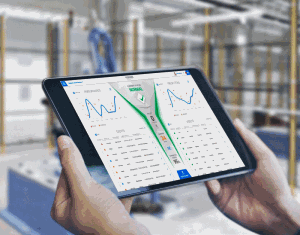
methods (especially offline simulation). MRK-capable planning tools are still in development. Estimating accessibility is still quite successful in practice, but designing interaction and safety spaces around systems/robots/grippers/devices is somewhat more difficult. Cycle times can only be determined subject to generalising assumptions. However, once the workstation is in operation, a statistical evaluation of the time shares can provide input and feedback for optimisation. This can be done conveniently using Industry 4.0 software (such as
Yaskawa Connected Factory).
Costs
Compared to the classic industrial robot, a collaborative robot is not cheaper to purchase, at least if one realistically takes into account the payloads and the significantly higher performance. If one then adds costs for collaborative grippers rather than simple jaw grippers, trap-free and injury-free design of the devices, HMI worker guidance, access and safety technology and finally the necessary safety assessment by the operator with a risk of the potential necessity for reworking, then the conclusion – contrary to popular opinion – is clear: A collaborative robot workstation in industry is generally more expensive than a conventional robotic cell.
Easy operation
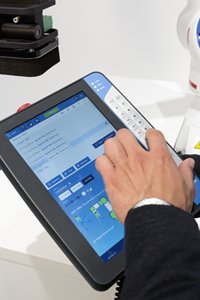
One great advantage of collaborative robot technology is how it simplifies operation, parameterisation and programming, in particular intuitive manual guidance but also the tablet-like re-design of the robot control unit (
Smart Pendant) as compared to the classic menu-based or code-based manual operating device (Teach Pendant).
Each of the three technologies has its benefits and drawbacks: manual guidance is good for frequent adjustments of simple pick and place applications – but it is hardly possible to teach remote laser or path processes to a hundredth of a millimetre with shaky hands. The classic handheld devices offers full functionality and is the first choice for experienced robot programmers if the application is rarely reprogrammed and the full logic, function and command scope of the robot controller is to be used. And a tablet-based user interface is a happy medium for the app generation. Each of these three technologies – and many more programming systems and aids – are now also available for classic industrial robots. Manufacturers who have both collaborating and classic robots in their portfolio offer all technologies as an option for all robots.
Simple commissioning and integration
Unboxing videos, e-Learning, FAQs, how-to blogs, plug&play – all these are to be found in the world of collaborative robotics, offering basic knowledge and simplifying commissioning for inexperienced users and system integrators. Unfortunately, and in spite of everything: very few robot workstations in industry can simply be "plugged together" by the inexperienced. System integrators and an expert knowledge of robot manufacturers are still needed – in the future possibly less for soldering the connecting cable plugs than for competent conceptual planning and consultation regarding the appropriate robot solution for the application in question, taking into account and anticipating subsequent safety assessment criteria from the outset.
Summary
Collaborative robotics is a fascinating new technology for applications where (true) human-robot interaction is required. It opens up a series of new applications for which classic robotics was previously too bulky or uneconomical.
Future developments in the field of collaborative robots will be aimed at:
- Increasing the payloads and range of collaborative robots in order to be able to use them in more demanding applications, providing relief for human beings
- Improving the operability of all robot systems (whether collaborative or not)
- Developing plug & play ecosystems
- Improving planning quality and tools relating to collaborative systems
- Modernising the robot-related “user experience”
Collaborative robotics will not replace classic robotics but will supplement it. It is a new element in the toolbox of flexible automation, which is first and foremost technology-neutral, committed to an intelligent, suitable and economical solution, and not to the unconditional implementation of collaborative robot technology.